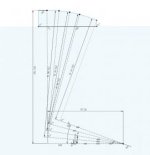I have a Harrison "Universal" milling machine. where "Universal" means that there are both a horizontal spindle, a pivoting vertical spindle and a swinging table.
The swinging table means that the machine can easily be set up for hobbing gears with spiral gear hobs.
Each hob has a lead angle engraved on it that tells me how far the table needs to be swung.
But the angles are typically something like 1°45' and the graduations on my table are every 1 degree and are fairly hard to see.
So I had the idea of using a micrometer head to dial in the angle. For small angles a 1mm micrometer at a distance of 57.29mm from the pivot moves the table 1 degree for every 1mm travel. ( 57.29 is calculated from 1/tan(1) ). An imperial micrometer head could be used at a distance of 5.729" from the pivot. Then it would, of course, be 1 degree for every 0.1" marking on the micrometer.
The problem is that this ceases to be accurate as the angles increase.
So I had the idea of having the micrometer bear on a specially shaped ramp that to correct for the disparity as the table swings:

The construction for the shape of the cam is shown below. It will be a different shape for every machine, as the distance from pivot to the micrometer face affects the profile.
The 0 degree line is constructed to put the end of the ramp in the right place for the other part dimensions. Then a similar construction is made at 5 degrres, and with a 5mm shorter construction line. This is repeated for a few angles.
The points can then be joined with a spline, and a CNC machine makes making the special shape fairly easy.

The swinging table means that the machine can easily be set up for hobbing gears with spiral gear hobs.
Each hob has a lead angle engraved on it that tells me how far the table needs to be swung.
But the angles are typically something like 1°45' and the graduations on my table are every 1 degree and are fairly hard to see.
So I had the idea of using a micrometer head to dial in the angle. For small angles a 1mm micrometer at a distance of 57.29mm from the pivot moves the table 1 degree for every 1mm travel. ( 57.29 is calculated from 1/tan(1) ). An imperial micrometer head could be used at a distance of 5.729" from the pivot. Then it would, of course, be 1 degree for every 0.1" marking on the micrometer.
The problem is that this ceases to be accurate as the angles increase.
So I had the idea of having the micrometer bear on a specially shaped ramp that to correct for the disparity as the table swings:

The construction for the shape of the cam is shown below. It will be a different shape for every machine, as the distance from pivot to the micrometer face affects the profile.
The 0 degree line is constructed to put the end of the ramp in the right place for the other part dimensions. Then a similar construction is made at 5 degrres, and with a 5mm shorter construction line. This is repeated for a few angles.
The points can then be joined with a spline, and a CNC machine makes making the special shape fairly easy.



 ) of experiments, gathering empirical data on what happened with each measure of inaccuracy in swivel angle setting.
) of experiments, gathering empirical data on what happened with each measure of inaccuracy in swivel angle setting.